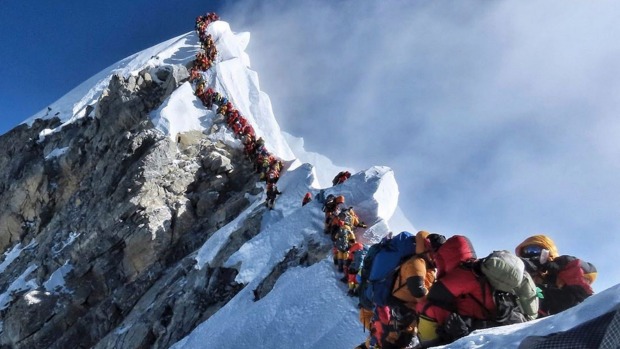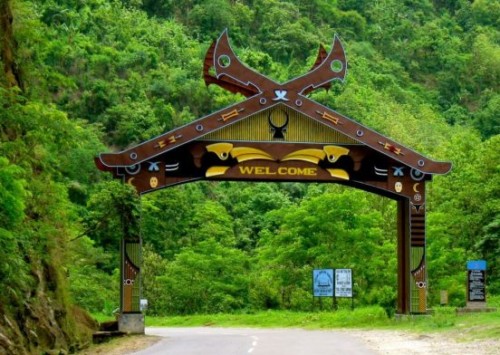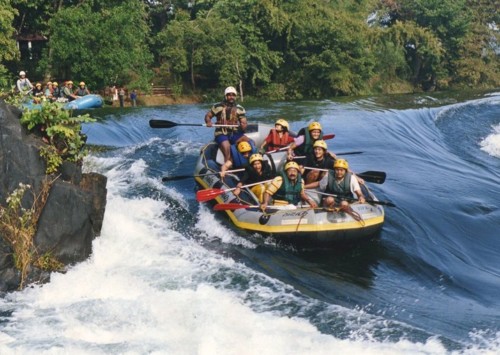Indian government opens 137 new doors for mountaineers
With the Indian government opening 137 mountain peaks for foreign travellers desirous of mountaineering, local organisations are against this decision as they feel it goes against the local religious beliefs and are urging the state government to preserve the sanctity of the holy mountains.
Sixty four years ago, on May 25, 1955, two British mountaineers – Joe Brown and George Brand led an expedition to the Kanchenjunga from the Sikkim route and stopped short of scaling up to the summit because of a promise they had made to the chogyal (monarch) that the top of the mountain would remain intact and the local beliefs would not be violated. Since that day till today, every climber or climbing group that has reached the summit has followed this tradition.
Sikkim that was once a remote mountain kingdom, ruled by chogyals until 1975; has opened itself to travellers and given them a peek into its exotic world of rich flora and fauna, serene monastic settlements, crystalline glaciers to the lakes and hot springs and the picturesque mountain passes. The state is also the base for mountaineering expeditions and excellent river rafting. In the past few years the state has become one of the most sought after tourist destination.
Recently, the Ministry of Home Affairs (MHA) announced the opening of 137 mountain peaks for foreigners desirous of obtaining Mountaineering Visa (‘MX’) for mountaineering and trekking. These peaks are located in the states of Jammu and Kashmir, Himachal Pradesh, Uttarakhand and Sikkim.
The list of peaks includes Kanchenjunga located at a height of 8,586 metre and Nepal Peak located at the height of 7,168 metre in Sikkim, Garur Parbat (6,504 m) and Purbi Dunagiri (6,489 m) in Uttarakhand, Mount Kailash (6,400 m) in Jammu and Kashmir and Mulkila (6,517 m) in Himachal Pradesh. For peaks that are “open” to expeditions, both foreign and Indian climbers can obtain permission directly from the Indian Mountaineering Foundation (IMF), the national body for mountaineering.
However, local organisations and stakeholders in Sikkim have requested the state government to preserve the sanctity of the holy mountains as they feel this decision goes against the local religious beliefs. Everester Kunzang Gyatso, who is also the president of the Sikkim Mountaineering Association (SMA), said mountaineers who wish to climb the Kanchenjunga can do it from the Nepal side without hurting religious sentiments of the locals.
Sikkim government officials and social organisations said many of these peaks, including Kanchenjunga, are protected as sacred places of Buddhist worship under provisions of the Places of Worship (Special Provisions) Act, 1991. Tseten Tashi Bhutia, the convener of the Sikkim Bhutia Lepcha Apex Committee, which espouses the cause of the two communities of Sikkim, said the decision to open the sacred peaks was “a blatant mistake”.
Of the 137 peaks, 51 are in Uttarakhand, 47 in Himachal Pradesh, 24 in Sikkim and 15 in Jammu and Kashmir.
The idea behind it
India has long been known for its rich culture and heritage. Tourists from all over the world have seen this as a destination with great cultural and spiritual significance. However, when it comes to adventurous and offbeat experiences, travellers had to spend most of the time in long paper works. Due to this bureaucratic situation international travellers preferred Nepal over India more as an adventure destination as over there getting permits from the Nepal Mountaineering Association (NMA), is much easier and less time consuming.
Since travellers now prefer the unconventional way of travelling, it has led the Indian government to highlight more prospects for such travellers. Captain Swadesh Kumar, president of the Adventure Tours Operators Association of India, who has been closely associated with the process of making these peaks more accessible, said the ultimate goal was to make all the peaks in the country accessible to everybody and project the Indian Himalayas as a serious adventure sport destination.
The decision might help locals and youth in getting employment and also help the economy of a state, feel tour operators. “The Indian government’s decision to open 137 peaks in India for foreigners is highly appreciated from business and employment point of view. Through this step not only the locally educated people will get job opportunities, but also entrepreneurs, transporters, hotels, airlines and many others will get business, which will create huge revenue for India,” says Sunil Dhoundiyal , a senior travel consultant for Sikkim Tourism India to Media India Group.
Risk of over-mountaineering
Prahlad Singh Patel, the tourism minister has emphasized on the need for ensuring safety of those travellers going for adventure tourism. He urged the states to exercise utmost caution while registering adventure tourism operators and also to ensure that the adventure tourism guidelines are followed by the states.
The Indian Adventure Tourism Guidelines 2018 cover land, air and water-based activities which includes mountaineering, trekking, bungee jumping, paragliding, kayaking, scuba diving, snorkelling, river rafting and many other sports.
The MHA has also stressed that the expeditions have to strictly follow approved routes. Mountaineers going off the set routes have been a common practice across expeditions and have led to many deaths/missing cases, the most recent one involving eight foreigners who died while climbing the Nanda Devi East Peak in Uttarakhand in May this year.
“Without any proper strategy, policies, or dos and don’ts, the environment can be affected. Proper rules, guidelines are mandatory for everyone to follow and protect the environment. We can take example of Mount Everest where thousands of mountaineers spread tonnes of garbage and it was a struggle for the government to clean them. So before conducting any trekking and mountaineering, government should make proper rules, policies for everyone,” adds Sunil.
The increasing footfall of mountaineering enthusiasts is creating a host of problems and therefore the Nepal government is considering tightening access to the world’s highest peak. The growing challenges of climate change, unpredictable rainfall, floods, landslides, snow cover melt and snow line retreat, directly affect the trekking and hiking experience. However, now the government plans to crack the whip by introducing a number of restrictions to save lives as well as the environment. One such initiative is the banning of single-use plastics from Everest and the surrounding region, starting January 2020.
The Himalayan region in India is also facing erratic weather events. Studies have shown that climate change is pushing up the odds of extreme events such as avalanches. “Climate change in the Himalayas is happening rapidly, in real time,” Thamban Meloth, a researcher heading an ongoing study that began in 2013, told IndiaSpend. Scientists from the National Centre for Antarctic and Ocean Research (NCAOR), Goa, and the India Meteorological Department (IMD), Delhi, are jointly conducting this study for the Indian ministry of earth sciences. The study is examining how global warming is affecting some of the 9,579 glaciers in the Himalayan region.
It remains to be seen whether India’s decision of opening 137 peak for tourists will truly lead to an influx of tourists and make India a growing mountaineering/trekking destination and whether it can build the infrastructure to handle a large number of mountaineers or will the country make the same mistake like its neighbour Nepal who issued unrestricted permits allowing huge crowds on its summits that led to deaths of some mountaineers from exhaustion, after being delayed due to overcrowding.













